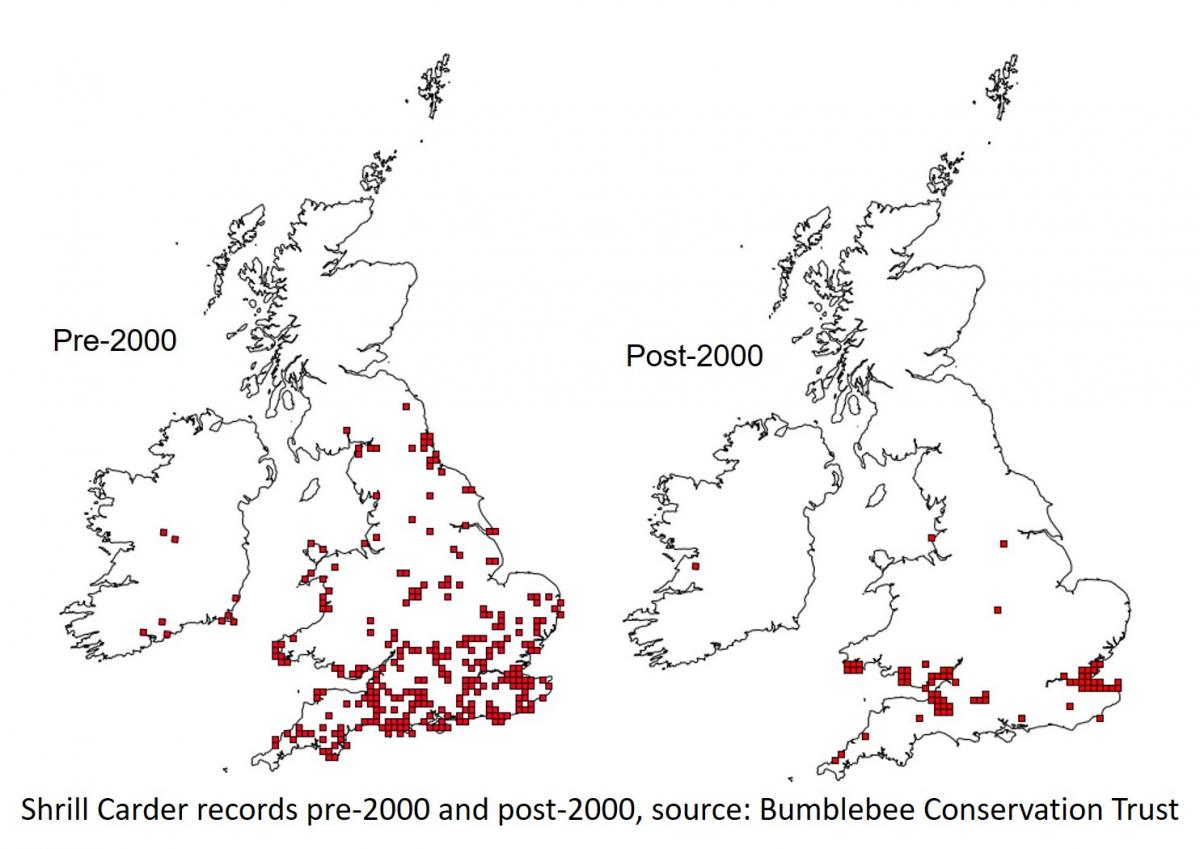BeeBlitzes, Bumblebees and other Bizarre Adventures
Guest blog by Rosa Pietroiusti. Rosa is a young person developing her career in conservation through working with the Bumblebee Conservation Trust's 'Making A Buzz' project and attended a FSC BioLinks training course on the field identification of flies this summer.
She’s squinting in the sunlight – a wide, excited smile – a little plastic pot in the foreground looks important… So, what’s in the pot?
Yes, you guessed it! That’s me in the photo, and the little pot hides a gorgeous Shrill Carder Bumblebee (Bombus sylvarum), the UK’s rarest bumblebee, currently working weekends as the irresistible ‘poster girl’ for Making a Buzz for the Coast – the exciting conservation project based in North Kent that took me in as a trainee for five months this summer, from May to September.
 What’s so special about the Shrill Carder Bumblebee? First of all, let’s learn to recognize her: the general color of her furry coat is between silver and yellow, but if you look carefully, you can see she has a faint black patch on her thorax and a lovely subdued ginger tail. She’s gorgeous isn’t she? Well, she’s also very endangered – previously quite widespread throughout the UK, she now only hangs on in South Wales and the North Kent Coast, and in only a few very small pockets in other parts of the country. And what’s more – taking a closer look at the Shrill’s distribution on a map shows us that even in North Kent the population is increasingly fragmented – and, sadly, small and isolated populations make for dangerously vulnerable genetics…
What’s so special about the Shrill Carder Bumblebee? First of all, let’s learn to recognize her: the general color of her furry coat is between silver and yellow, but if you look carefully, you can see she has a faint black patch on her thorax and a lovely subdued ginger tail. She’s gorgeous isn’t she? Well, she’s also very endangered – previously quite widespread throughout the UK, she now only hangs on in South Wales and the North Kent Coast, and in only a few very small pockets in other parts of the country. And what’s more – taking a closer look at the Shrill’s distribution on a map shows us that even in North Kent the population is increasingly fragmented – and, sadly, small and isolated populations make for dangerously vulnerable genetics…

Making a Buzz for the Coast is the Bumblebee Conservation Trust’s youngest, HLF-funded, project [you can see all the BBCT projects here]. The project team entered full motion in November 2017, with the aim of studying and supporting the rare species of bumblebee that live along the North Kent coastline. The project’s team works with partners that include the RSPB, Natural England, Kent County Council and Thames Water to create and manage habitat for these important pollinators, as well as to spread awareness among community groups and local schools, and involve everyone in doing their bit for bees – be it planting bee-friendly plants in their garden, or working as a citizen scientist by uploading bumblebee sightings through iRecord or even by setting up a BeeWalk, the Bumblebee Conservation Trust led national monitoring scheme for bumblebees [You can set up your own BeeWalk too, and become a Bee-Hero! Read how-to here]. The Bumblebee Conservation Trust also runs regular BeeBlitzes, a day when all the volunteers that want to participate, can grab a hand lens and scan a territory to identify as many bumblebees as possible to species level, taking note of what flowers they were feeding on. All this data and information is vital for us to know how bumblebees are doing throughout the UK, and where and how the Bumblebee Conservation Trust and other similar organisations can best employ their conservation efforts.

During my time with Making a Buzz, I collaborated with Volunteer and Outreach Officer Lauren Kennedy to spread the love of bees: we set up stalls at fairs and events, led walks, talks and workshops with local groups and schools, and created outreach resources and displays that we peppered throughout North Kent. I also learned about habitat management and botanical surveying while working with Conservation Officers, Bex Cartwright and Kate Fidczuk-Sterry, in conservation sites that include RSPB Nature Reserves such as Northward Hill public paths at Foreness Point, and farms looking to become more bee-friendly.
My role with the Bumblebee Conservation Trust also gave me the opportunity to participate in lots of excellent training courses. One of these was a course on the Field Identification of Flies led by Dipterist Martin Harvey and organized by the brilliant Biolinks project, which helped me learn how to tell wanna-bee hoverflies apart from real bees [read here about Martin Harvey’s adventure on this day, finding a rare soldierfly species]. Biolinks is a great opportunity for young people interested in invertebrates and conservation – it is a Heritage Lottery funded project that offers a great variety of courses on invertebrate identifying and recording at unbeatable prices! [Find out more about FSC BioLinks training opportunities via our Training menu]
If you are interested, keep your eyes peeled for upcoming Biolinks and FSC courses, Bumblebee Conservation Trust traineeship opportunities, as well as BeeBlitzes and public events. If you want to be a citizen-science-superstar, set up your own BeeWalk and start walking it in March 2019! Contact the Making a Buzz for the Coast team with any questions, curiosities and to get support with BeeWalk, or follow them on Twitter!
Bees Out,
Rosa
1st October 2018
- Anonymous's blog
- Log in or register to post comments



